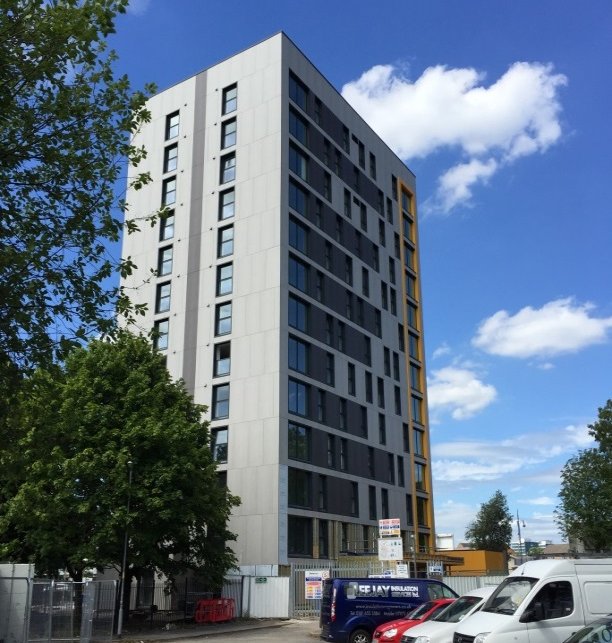Regenerated Tribe Apartments in Manchester achieve BREEAM Outstanding
Overview
The Tribe apartments project gave a new lease of life to three empty tower blocks in Ancoats, Manchester. It was awarded a BREEAM rating of Outstanding, and won a BREEAM Award in 2017 for its achievements. The assessor, Energy Council, worked closely with the architect, developer and contractor teams to develop the energy and environmental proposals. They provided the energy and BREEAM pre-assessments for the planning applications and developed the strategies to improve the building thermally and sustainably.
Background
The ‘Tribe’ domestic refurbishment project concept was to take three existing, empty, dilapidated and uninhabitable 13-storey 1950s apartment blocks in inner city Manchester and bring them back to life. The aim was to create modern, affordable, spacious apartments with inner city centre living. The project cost was around £17 million.
The three blocks are centrally located within a ten minute walk of the Manchester city centre. Greater Manchester is the third largest conurbation in the UK with 2.3 million people and 6.4 million within a 30 mile radius and its population is expected to grow by 385,000 per annum until 2031. This means there is increased demand for quality property, which is not being met by new stock, and very little housing is being built specifically for private rental.
Challenges
The three blocks had all been uninhabitable since 1994 and were in a very poor state of disrepair. The blocks had clearly been vandalised and infested by vermin for many years whilst unoccupied and were a ‘blot on the landscape’ for the city council and local residents. The blocks had no useful maintenance and electrical services infrastructure as it was either vandalised, stripped out, or inoperable. Previous developers had been put off from upgrading these buildings due to scale and nature of the projects.
Manchester City Council’s planners set a requirement for the project to achieve a BREEAM Very Good rating. The client wanted to go beyond these expectations, with an aspiration to meet an Outstanding rating. A single BREEAM assessment was carried out on the three blocks on a ‘worst case’ performing basis. The Outstanding rating has been realised through early conceptual planning, attention to detail through the design and construction process and lots of hard work.
Solutions
The existing blocks each previously contained 62 flats (186 in total) and two additional flats have been created at ground floor level, making a total of 192. The refurbished buildings have been remodelled internally to create larger and more usable dwellings. The reinforced concrete frames of each block have been stripped inside and out, their structures entirely refurbished to incorporate significant energy-efficient measures designed to reduce carbon emissions and save on energy bills.
Energy Council involvement
Energy Council were involved in the early conceptual stages of the project providing the developer and contractor teams with pre-planning design advice and guidance. Early concept existing and proposed layout drawings were produced by Pozzoni Architects. Energy Council worked closely with the architect, developer and contractor teams to develop the energy and environmental proposals.
They provided the energy and BREEAM pre-assessments for the planning applications and developed the strategies to improve the building thermally and sustainably.
Energy Council undertook a site visit to each existing flat block visiting every flat and undertaking a comprehensive Chartered Surveyors Report for ECO/ BREEAM purposes prior to strip out. We carried out the Part L SAP and ECO pre-install assessments on all the flats and calculated the baseline energy and emissions. The post install SAP calculations were undertaken early to estimate the improved energy and CO2 emission reductions and cost savings from each proposed improvement measure for ECO and BREEAM. These calculations allowed each energy improvement measure to be considered, quantified and evaluated.
Energy efficient façade
The existing blocks incorporated balconies on 2 elevations, which were formed by the extension of the existing structural concrete floors at each level. This created a large thermal bridge through the structure which affected 70% of the existing flats. By extending and wrapping a new thermally efficient external façade around the existing balconies it has eliminated the thermal bridge and created more habitable space. This in turn allowed the apartments to be internally remodelled to optimise the useful space creatively reconstructing them to suit today’s lifestyles with lovely big rooms, and amazing views.
Other energy efficiency measures
Creation of new habitable space by encasing balconies in new external façades to allow remodelling of apartments on over 70% of the flats and reduce thermal bridging
All apartments perform on average 65% better than a new build apartment built to current building regs L1A 2013
New thermally efficient façade using external wall insulation
Upgraded insulated roof
New doors and glazing throughout
Wrap-around glazed facades on over 70% of apartments to optimise daylighting and views
Reduced thermal bridging on all junctions within the building which minimises heat loss and reduces risk of thermal bridging
New part F compliant ventilation using high efficiency continuously running fans with boost facility when wet rooms are in use
New centralised wood pellet biomass boiler plant to provide heating and hot water to each flat
New heat interface units and heat meters to each apartment
New low energy LED lighting throughout apartments and communal circulation space
Low internal water consumption appliances throughout improving upon current building regulationss by 25%.
Pre and post air leakage and IR thermography testing undertaken – pre improvement average leakage 22m3/m2/hr, post improvement <4.5m3/m2/hr.
Low construction waste as much of the existing super structure was re-used
Remediation of the site to remove contamination
Involvement of a chartered ecologist has enhanced the site’s surroundings and ecological value

